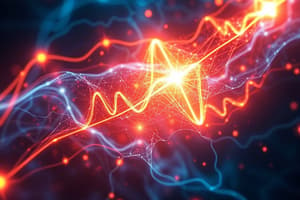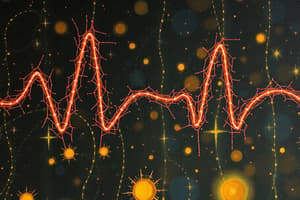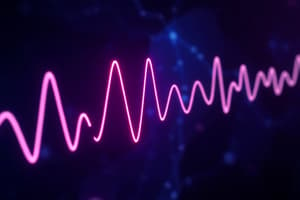Podcast
Questions and Answers
What is true about the absolute refractory period during an action potential?
What is true about the absolute refractory period during an action potential?
- It occurs immediately after repolarization is completed.
- No amount of stimulation can initiate another action potential. (correct)
- It is primarily a result of increased potassium permeability.
- It allows some ion channels to be activated.
Which of the following accurately describes the relative refractory period?
Which of the following accurately describes the relative refractory period?
- The membrane potential is more positive than the resting state.
- It occurs when the membrane is completely depolarized.
- It is characterized by a total absence of ion channel activity.
- Stronger than normal stimulation can generate an action potential. (correct)
What mechanism primarily contributes to the propagation of action potentials along an axon?
What mechanism primarily contributes to the propagation of action potentials along an axon?
- Passive diffusion of ions through the cytoplasm.
- Sequential opening of voltage-gated sodium channels. (correct)
- Release of neurotransmitters at the axon terminal.
- Contraction of muscle fibers surrounding the axon.
Graded potentials differ from action potentials in that they are characterized by:
Graded potentials differ from action potentials in that they are characterized by:
What factor most significantly influences membrane permeability to ions during an action potential?
What factor most significantly influences membrane permeability to ions during an action potential?
What occurs during the absolute refractory period?
What occurs during the absolute refractory period?
What characterizes the relative refractory period?
What characterizes the relative refractory period?
How is the propagation of action potentials primarily achieved along axons?
How is the propagation of action potentials primarily achieved along axons?
What is a distinguishing feature of graded potentials?
What is a distinguishing feature of graded potentials?
What primarily influences membrane permeability during the undershoot phase of an action potential?
What primarily influences membrane permeability during the undershoot phase of an action potential?
Flashcards are hidden until you start studying
Study Notes
Undershoot and Action Potential Dynamics
- High K+ conductance persists after reaching resting membrane potential (RMP), driving membrane potential close to K+ equilibrium.
- During action potential, depolarization leads to rapid changes in ion channel permeability, specifically through voltage and ligand-gated channels.
Ion Channels and Membrane Permeability
- Ion channels are integral proteins that enable selective diffusion of specific ions, determined by channel size and charge distribution.
- Conductance depends on the probability of channels being open; higher open probability results in higher conductance.
Voltage-gated Channels
- Voltage-gated Na+ channels activate at threshold (-55 mV), significantly increasing Na+ permeability and initiating depolarization.
- Inactivation occurs as the membrane potential reaches +35 mV, resulting in decreased Na+ permeability and the start of repolarization.
Ligand-gated Channels
- Ligand-gated channels respond to neurotransmitters, e.g., acetylcholine binding to nicotinic receptors causes channel opening that allows Na+ and K+ flow.
Membrane Potential Terminology
- RMP is the polarized state of the membrane, generally around -70 mV to -90 mV.
- Depolarization occurs when the membrane potential becomes less negative; repolarization follows as membrane returns to resting state.
- Hyperpolarization makes the membrane potential more negative than the resting state.
Action Potential Fundamentals
- Action potentials are rapid depolarizations followed by repolarization in excitable cells.
- Threshold potential is reached when depolarization increases by 15-20 mV beyond resting potential, initiating a self-sustaining action potential.
- All-or-none phenomenon: action potentials occur fully or not at all.
Ionic Basis of Action Potential
- Resting membrane potential results from high K+ conductance via leaky K+ channels, keeping the cell interior negative.
- During an action potential:
- Inward current reaches threshold, rapidly opening voltage-gated Na+ channels, leading to increased Na+ conductance.
- Membrane potential overshoots towards Na+ equilibrium potential (+65 mV) during rapid depolarization.
Repolarization Mechanism
- Na+ channels inactivate and conductance returns to zero during repolarization.
- Slow-opening voltage-gated K+ channels increase K+ conductance, resulting in outward potassium current, repolarizing the membrane.
- Tetraethylammonium (TEA) blocks K+ channels, influencing repolarization dynamics.
Clinical Relevance
- Neurotoxins like tetrodotoxin (TTX) and lidocaine block voltage-sensitive Na+ channels, which prevents action potentials, providing analgesic effects.
Studying That Suits You
Use AI to generate personalized quizzes and flashcards to suit your learning preferences.




